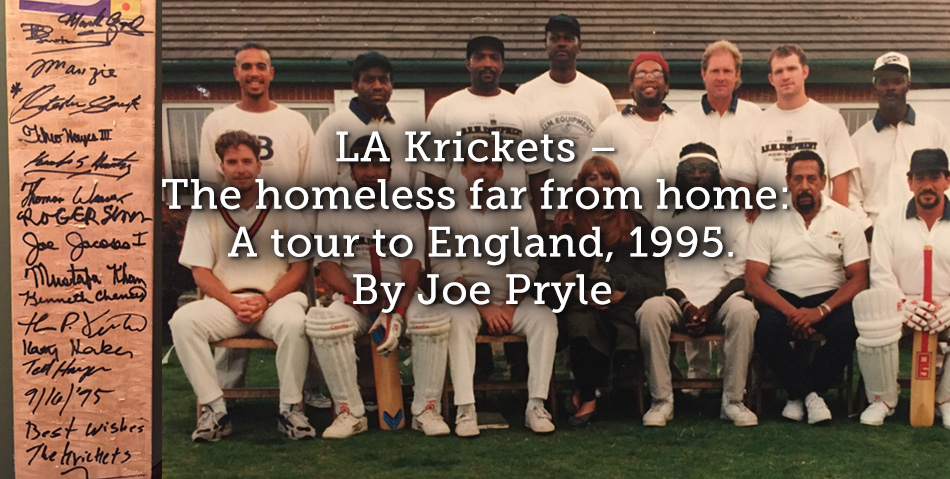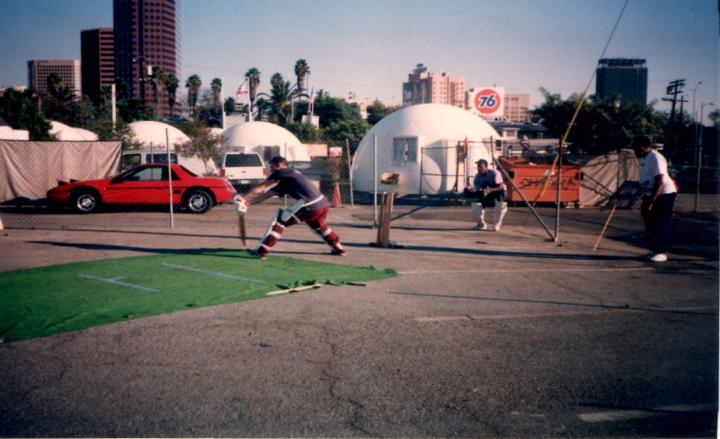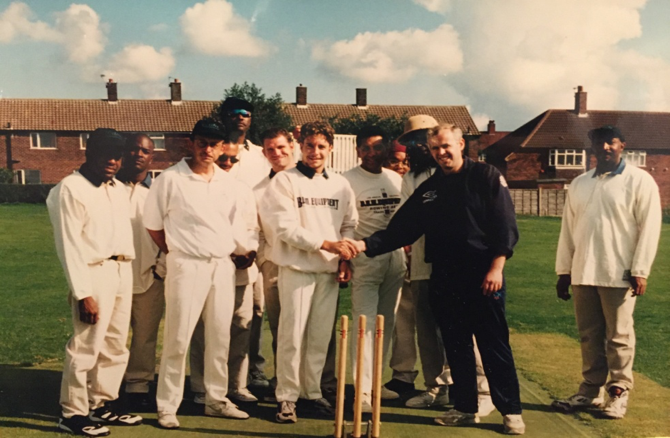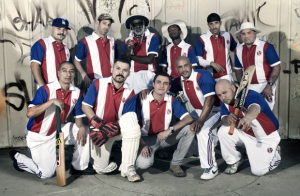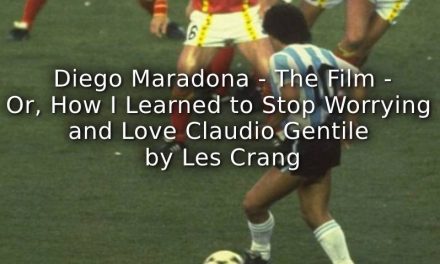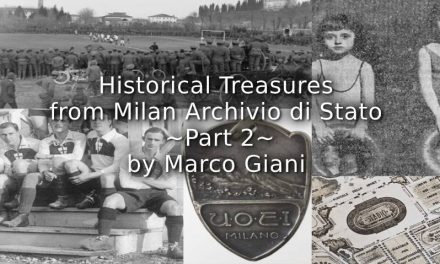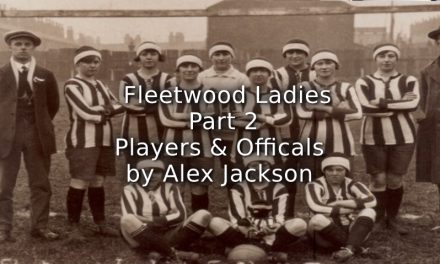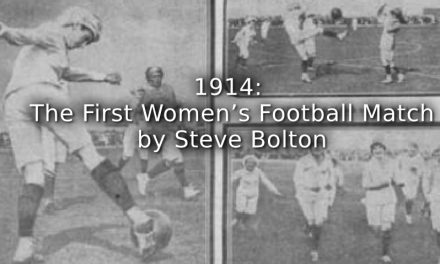- LA Krickets team photo prior to first game of the tour at Blackrod CC, Bolton, Lancashire. September, 1995. (Mustafa Khan is 4th from left, back row. Front row from left: Stephen Speak, Mark Azeez, David Sentance, Katy Haber, Ted Hayes)
Following the Los Angeles riots in 1992, where many parts of the city became engaged in a conflict between the local community and the police, there was much distrust and tension that threatened to divide the whole city, and potentially the nation. The reason for this stemmed from an incident involving a local man, Rodney King, and police officers who had used excessive force when implementing a stop and search procedure. The police officers were initially excused from the incident, despite Mr King receiving up to 40 baton blows. As Mr King was from an African American background, this created racial tension leading to riots throughout the city, predominantly around the South Central and Downtown areas. In addition, the shooting and killing of Latasha Harlins, a 15-year-old African American girl, by Korean shopkeeper Soon Ja Du increased tensions between the black and Asian communities in Los Angeles. The fact that Du was convicted but served no prison time exacerbated the ill feeling from the black community, who saw an imbalance of justice. For this reason, many Korean shopkeepers felt the most of the wrath during the riots. 55 people died, over 2,300 were injured and there were over 7000 fires, creating over $1billion in damages. Over 4000 National Guard soldiers were called in to disperse the trouble – it was the largest civil unrest in America in the 20th century.
The combination of these two infractions by predominantly white middle class court rulings created a divide within the communities of South Central that would take some time to overcome. The 7.6 earthquake that hit LA in 1994 increased the fear and apprehension amongst communities, and increased homelessness, and this became a concern of Prince Charles when he visited later that year. Cricket was amongst the powerful tools used to bring some of these communities together.
In 1995, social activist and homelessness campaigner Ted Hayes, himself a man who claimed to once have Marvin Gaye’s back garden as his primary address, teamed up with Hollywood producer Katy Haber to use cricket as a means to instil civilized values into the homeless – forming the LA Krickets in the process.
Haber called up Hayes as a favour, to help a friend out from the Beverly Hills Cricket Club, as she knew he had previously played baseball. However, he was unaware of the sport of cricket but once introduced, he fell in love with its genteel image, and saw that it could enhance some qualities such as leadership, respect, discipline and etiquette far more than other sports. Together they established a cricket programme within the Dome Village, a homeless shelter underneath the Harbor Freeway in the Downtown area of LA. It became known as Justiceville and initially the team would be the Justiceville Krickets. Local cricket administrator and coach David Sentance, himself an avid historian on the game with close links to England, suggested that they teach the game to the homeless, and brought in some coaches to help introduce the skills. Mark Azeez, of Guyanan descent and Mustafa Khan, a former professional basketball player from the Compton area of LA, combined with Sentance and Stephen Speak, a professional from the Lancashire Leagues in England to provide sessions and develop the skills of this collective. In addition, by including players from all ethnic backgrounds, the prior problem of race division started to decrease, and would help to form a social identity for these people.
- Stephen Speak demonstrating batting to the homeless at the Dome Village, Los Angeles
A passing group of British businessmen saw them playing and came up with the idea for a tour to England. The South Coast Metropole as they were known, had arrived in LA to promote business in Bournemouth, Poole and Southampton, and had links to the British American Chamber of Commerce cricket team. As the homeless group were a transient bunch of individuals, it was decided that this be as soon as possible. In late summer 1995, Haber was able to use her vast contacts within the business and movie-making world to obtain a number of sponsors, including Prudential Life Insurance, Tommy Boy records and B.U.M equipment, who supplied the clothing. The tour was on and Sentance had been able to assemble a team that could make a difference and included Jewish, Muslim, Irish, English and Australian personnel in addition to the African Americans. It was a team that symbolised diversity, and just 3 years on from the riots demonstrated a change for the better.
The tour began with a game against Speak’s hometown club of Blackrod in Bolton, where the players were able to bed down for the night in the clubhouse. Speak scored a century against this old club but the Krickets did not have enough to win the game. They were learning lessons about camaraderie and team work. Following a breakfast they moved on to Rutland, where wet conditions again taught the team about adaptability. Ridlington CC, the hosts left a target of 113 from 25 overs, which was achieved from the last ball and gave the Krickets their first win. It was performances like this that would unite the team as they moved south towards London.
In London, funds had run low and there was a feeling that they would revert to becoming homeless again, perhaps camping out in Hyde Park. However, a mystery benefactor provided funds and the Prince’s Trust helped to provide accommodation at the Bedford Hotel. Whilst in London, the team visited Lord’s and even got to try out the indoor nets. The tour moved onto the south coast where they would play at the Hambledon Cricket Club, close to where the South Coast Metropole were based, but importantly is widely recognised as the birthplace of organised cricket. The homeless cricketers were symbolically coming home.
The Krickets played six games on the tour and proved that there is an audience for local cricketers from America. This was evident in the aftermath, as many local news stations broadcast footage, and reporters turned up at LAX airport clamouring for the story. For 15 minutes, this team of homeless cricketers had their moment in the spotlight. Hayes became the face of the group, and his promotion, combined with Haber’s networks, almost led to a deal with Disney to create a script for a movie. However, disputes led to the disbandment of the original team and the opportunity was lost.
- ‘Peace’ bat containing signatures of LA Krickets 1995. Many of these were handed out as a gesture with many opponents, as a symbol of unification – the core principal of the team in the wake of the riots
Now over 20 years later, Hayes and Haber continue with a cricket team in South Central LA, now called The Homies and The Popz (Compton Cricket Club), but this is now predominantly loaded with Latinos. They have had 3 more tours to England, and have met with Irish leaders David Trimble and Gerry Adams to improve peace relations. A tour to Australia also helped community relations by playing against an Indigenous XI. Prince Edward, John Major and Bill Clinton have also endorsed their project. Azeez, Khan and Sentance have developed a junior cricket development program in the South Central LA area and continue to try and use its influence to instil character and values into young people, whilst Speak went on to break the world record for batting non-stop for 24 hours at a school just outside of LA. He now lives far away from cricket in the wilderness of Idaho. Ultimately, cricket has demonstrated that sport can unite communities and provide a glimpse of the world for some that would otherwise not be possible.
- The LA Krickets today are known as The Homies and The Popz:Compton Cricket Club and continue to use cricket to engage with disadvantaged groups in Los Angeles
Article © Joe Pryle
References:
Baldassare, M. (1994) Los Angeles riots: lessons for the urban future. Westview Press, Boulder, CO.
Erickson, A. (2013) Foam finger: the 17 year long story and latest dream – of the Compton Cricket Club [online]. Available at: http://www.lamag.com/citythinkblog/foam-finger-the-17yearlong-storyand-latest-dreamof-the-compton-cricket-club/ (Accessed 1 April 2017)
Little, J. (2013) Interviews: The Compton Cricket Club [online]. Available at: http://www.ofipress.com/comptoncricketclub.htm (Accessed 1 April 2017)
Pool, R. (1995) Homeless Globetrotters: cricket team from Downtown camp headed for Britain [online]. Available at: http://articles.latimes.com/1995-09-15/local/me-46079_1_cricket-team (Accessed 1 April 2017)
Sentance, D. (2006) Cricket in America, 1710-2000. McFarland, Jefferson, NC.
Speak, S. and Pryle, J. (2015) Cricket Mercenary. Blurb: Bolton, UK. ISBN: 978-1-32-091367-6

